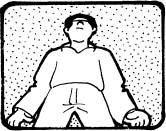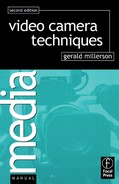Whenever you shoot down onto a subject the viewpoint may appear natural enough, but it will not necessarily show the subject itself most effectively. It may be better to raise the subject up until it is nearer to the normal camera height, (e.g. place it on a table), or lower the camera so that its viewpoint is level with the subject.
When you are shooting something on the ground, you will get much more striking pictures if the camera is around floor level (a ground shot), than with a down-tilted camera at the normal height. But will this ‘dog’s-eye’ view appear strange or inappropriate in the context of the program?
Most subjects tend to look impressive or important if you shoot them from just below the normal eye-line. But take care, for some can take on a very strange and uncharacteristic appearance and turn into ‘puzzle pictures’! When you shoot upwards from a very low angle, you will often find that the background dominates or even overwhelms many subjects.
Shot from a low angle, a person can be made to appear imposing, threatening, powerful. Even their most innocent actions – a glance, an outstretched arm – can seem significant. If you are using a wide-angle lens, this effect will be exaggerated even further. So from an artistic point of view, always select low camera positions with care!
Even if a camera does not have to move, it can be very tiring to operate its controls while crouching or kneeling for any length of time. It may be hard to see into the viewfinder properly, to focus and maintain good composition – particularly if lights are reflected in its screen. A further hazard of low viewpoints is that even quite low furniture (chairs, tables) can easily get in the way of the shot.
If you cannot lower the camera sufficiently to get the shot you want, it may help to use a mirror or a periscope attachment. But if the camera has to move around on shot, some sort of low-angle dolly or ‘creeper’ is the best solution. A typical height range for these special mountings is around 0.1 – 0.6 m/4in –2 ft. With a hand-held camera, even a castered board may help you to get the occasional low shot! For a stationary shot, you can fix a camera onto a high hat – a short cylindrical mounting, which can be bolted onto any firm surface (a board, box, or post).
Terms
You can get low-angle viewpoints by using a low camera position, by placing the subject higher than the camera or by shooting via a floor mirror.

Impact
Low-angle shots make most subjects appear stronger and more imposing.

Low-angle dolly
Specially designed dollies are sometimes used when shooting continuous action from a low angle.

